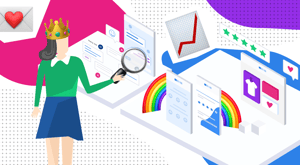Customer engagement is the connection between a customer and a company or brand through various channels of correspondence.
At Pisano, we believe good customer engagement is essential to offering delightful experiences. Yet, lots of teams have trouble deciding when, where and how to engage with customers. That's why we'll go through all the things you need to know when building your customer engagement strategy.
Here are some things to consider in your customer engagement strategy.
Touchpoints
One major factor that will determine your customer engagement are touchpoints. The points or moments along the customer journey where customers interact with your company and brand.
For instance, customers may discover your business on the web or in a promotion, visit your website, shop at your retail location, contact your help desk or customer service centre. These are all touchpoints that you may choose to engage customers in some way.
That's why identifying points where there are opportunities for taking instant action via human engagement or automated outreach is the first step in building your strategy.
Goals
Another important factor in effective customer engagement is having a clearly defined goal – the purpose for your engagement. Remember, alignment with business goals at every stage is paramount.
What would you like to achieve? Sales, loyalty, awareness… whatever it is, having a concrete goal will ensure your message is to the point and will resonate with your audience.
One thing to look out for, when setting your engagement goals, is your customers' feelings and sentiment towards your brand at that point in time.
For example, you might want to promote new products to a group of customers in order to increase sales. But if there are customers that have had a bad experience recently in that group, it might be better to exclude them from that specific engagement. A better goal for these types of customers might be trying to win them back with special discounts, free services or treats.
Message
When determining your message and tone, it's useful to try to figure out the feelings of your customer at the touchpoint you're engaging through.
A great way to understand customer feelings is by conducting real interviews. In alignment with the words of your customer, you will ensure your message resonates.
The format or touchpoint of your engagement is important here too because it will dictate the limits and dynamics of the medium. For example, you need to consider the character limit on Twitter if you're planning on engaging with customers there. Or if you're planning to use a billboard, you need to make your message more concise.
Conditions
Now that you've decided your message, touchpoint and goal you need to consider the conditions that you'll engage with customers — exactly the customers you're targeting.
You don't want to have a spray-and-pray approach to your engagement. You need to narrow down your audience and a great way to do this is to define certain conditions to your engagement.
Personalization is also important in engagement so making sure your message is relevant to the targeted persona is paramount.
Finally, you need to be careful not to overwhelm customers. You need a sense of priority when you decide on what conditions you engage customers — not too much or not too few.
Alerts
Automated alerts are a good way of ensuring no engagement opportunities are missed. By using alerting tools and technology you can make sure you get informed about issues and you don't miss a beat.
For example, you could set a rule that sends an email alert to the support team when a high-value customer has provided negative feedback. So that you can make sure you have an opportunity to solve the customers' issue proactively.
Similarly, you can set alerts for customers that haven't visited your website or your store in a long time. So that you have the chance to re-engage them with special offers and promotions.
Escalations
Escalations are time-based automated actions that trigger when certain criteria are or aren't met in a pre-determined time frame.
Say that you have a customer who wrote to you through your support email address and they're waiting for a response from the customer support team - you could set up a rule that notifies the customer support team leader if no one responds within 15 minutes.
By using escalations, you can make sure things don't slip through your fingers. And you always have a Plan-B if things get hectic.
Feedback
Finally, you should consider asking for feedback after you engage with the customer. A simple rating question based on NPS, CSAT or CES can work wonders. This will allow you to continuously improve your operations by iterating on potential problems and fixing things as you go.
It will create a flywheel effect - with more feedback you'll re-engage customers and with more engagement you'll have more feedback.
But when asking for feedback, it's important to determine a goal and a responsible. Why do you need the feedback? What are you going to change based on it? Who is going to keep track of it? All of these aspects of your program are crucial in determining whether you'll fail or succeed.
* * *
Now that you have all the necessary elements for a successful customer engagement strategy, why not have a go at it! All you need is a team, whiteboard and customer engagement tool like Pisano 😉
This article is based on Pisano CX Workshop workbook content. If you're looking to set better goals which will improve your customer experience strategy. We'd love to connect and organize a workshop for you and your team!




